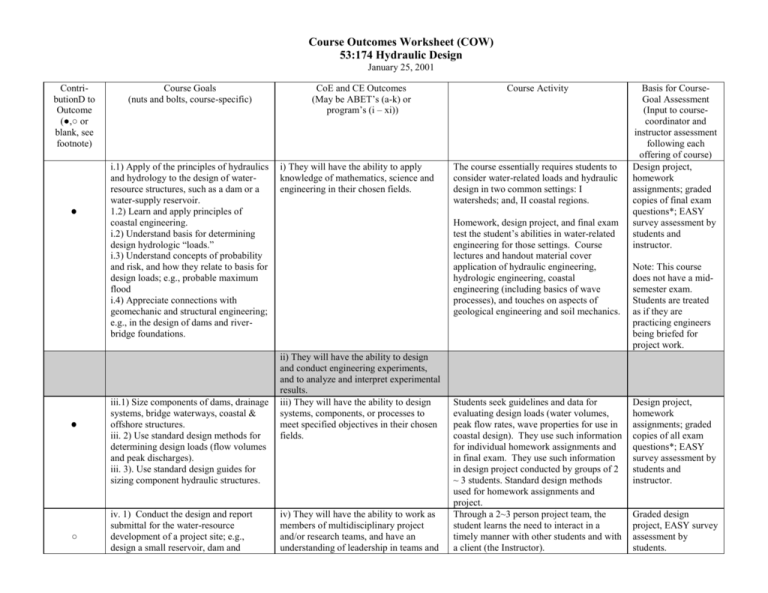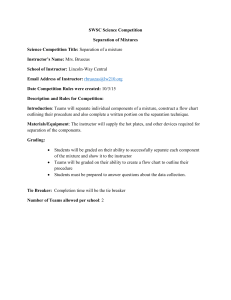53:174 Hydraulic Design
advertisement

Course Outcomes Worksheet (COW) 53:174 Hydraulic Design January 25, 2001 ContributionD to Outcome (●,○ or blank, see footnote) ○ Course Goals (nuts and bolts, course-specific) i.1) Apply of the principles of hydraulics and hydrology to the design of waterresource structures, such as a dam or a water-supply reservoir. 1.2) Learn and apply principles of coastal engineering. i.2) Understand basis for determining design hydrologic “loads.” i.3) Understand concepts of probability and risk, and how they relate to basis for design loads; e.g., probable maximum flood i.4) Appreciate connections with geomechanic and structural engineering; e.g., in the design of dams and riverbridge foundations. iii.1) Size components of dams, drainage systems, bridge waterways, coastal & offshore structures. iii. 2) Use standard design methods for determining design loads (flow volumes and peak discharges). iii. 3). Use standard design guides for sizing component hydraulic structures. iv. 1) Conduct the design and report submittal for the water-resource development of a project site; e.g., design a small reservoir, dam and CoE and CE Outcomes (May be ABET’s (a-k) or program’s (i – xi)) i) They will have the ability to apply knowledge of mathematics, science and engineering in their chosen fields. Course Activity The course essentially requires students to consider water-related loads and hydraulic design in two common settings: I watersheds; and, II coastal regions. Homework, design project, and final exam test the student’s abilities in water-related engineering for those settings. Course lectures and handout material cover application of hydraulic engineering, hydrologic engineering, coastal engineering (including basics of wave processes), and touches on aspects of geological engineering and soil mechanics. ii) They will have the ability to design and conduct engineering experiments, and to analyze and interpret experimental results. iii) They will have the ability to design systems, components, or processes to meet specified objectives in their chosen fields. iv) They will have the ability to work as members of multidisciplinary project and/or research teams, and have an understanding of leadership in teams and Students seek guidelines and data for evaluating design loads (water volumes, peak flow rates, wave properties for use in coastal design). They use such information for individual homework assignments and in final exam. They use such information in design project conducted by groups of 2 ~ 3 students. Standard design methods used for homework assignments and project. Through a 2~3 person project team, the student learns the need to interact in a timely manner with other students and with a client (the Instructor). Basis for CourseGoal Assessment (Input to coursecoordinator and instructor assessment following each offering of course) Design project, homework assignments; graded copies of final exam questions*; EASY survey assessment by students and instructor. Note: This course does not have a midsemester exam. Students are treated as if they are practicing engineers being briefed for project work. Design project, homework assignments; graded copies of all exam questions*; EASY survey assessment by students and instructor. Graded design project, EASY survey assessment by students. ○ ○ ○ appurtenant facilities v.1) Apply concepts of hydraulics and hydrology theory in the hydraulic design of a water-resource project involving multiple considerations; e.g., water for use, drainage, with consideration to adjoining facilities, such as bridges. v.2) Understand issues of water-volume and flow rate produced by watersheds of various size and geographic location v.3) Size a reservoir and dam. v.4) Size a water-supply system. v.5.) Check hydraulic adequacy of a bridge opening. vi.1) Appreciate the consequences of dam development; e.g., the consequences upstream, at site, and downstream vi.2) Ibid for development of a bridge crossing, and for a coastal development. vi.3). Appreciate need to work with other disciplines; e.g., in natural and social sciences vi.4). Appreciate the need and role for Environmental Impact Assessments (EIA) vii-w.1) Prepare a team written project report submitting a preliminary design with EIA to client. organizations. v) They will have the ability to identify, formulate, and solve engineering problems. Homework problems and design project that entail estimation of design load (e.g., a hydrograph or a wave train), and that then entail sizing a structure to handle the load.. EASY survey assessment by students and instructor; graded copies of all homework solutions and exam questions*. vi) They will have an understanding of professional and ethical responsibility and the value of mentoring and peer support. Lectures include discussion of professional and ethical responsibilities in design; e.g., in assessing acceptable design risk; and, in considering inadvertent consequences of a project like a dam. Part of this discussion focuses on the need for standardized calculation procedures and generally accepted design guidelines for assumed loads (analogies are drawn with design codes developed for steel and concrete buildings). Design project and final exam; EASY survey assessment by students and instructor. vii-w) They will have the ability to communicate effectively in written form. Students write one project report, which includes sequenced submissions of design calculations for components (e.g., estimating the design hydrograph for a small dam at a project site) of the overall design project. The project counts for 25% of the course grade. EASY survey assessment by students and instructor; graded copies of final report. The project report includes drawings, sketches, and graphs. Students must read topographic maps and be able to work with engineering drawings. EASY survey assessment by students and instructor; graded copies of final report. EASY survey assessment by students and instructor; graded copies of final report. vii-g.1) The project report includes layout drawings, sketches, photos, and graphs. vii-o) They will have the ability to communicate effectively in oral form. vii-g) They will have the ability to communicate effectively in graphical form. viii.1) In discussing hydraulic design, the course touches on the following considerations: local needs for water, local design preferences, variations in priorities for water use, and variations in acceptable design risk. viii) They will have an education that is supportive of a broad awareness of the diversity of the world and its cultures, and that provides an understanding of the impact of engineering practice in the global community. As for Objective vi. ○ ix. 1) Appreciate the need to follow consistent and accepted design methods. ix.2) Appreciate the need to be aware of latest design-load guidelines; e.g., for determining probable maximum flood. ix.3) Appreciate knowledge gaps, which research attempts to reduce. x.1) Discuss issues of water use. x.2) Discuss issues in coastal protection x.3) Present limits in design knowledge. ix) They will understand the importance of updating and maintaining their technical skills and continuing their education throughout their professional careers. As for Objective vi. EASY survey assessment by students and instructor; graded copies of final report. x) They will have knowledge of contemporary issues. Final exam, project, and EASY survey assessment. xi.1) xi.2) xi.3) xi.4) xi.5) xi.6) xi.7) xi) They will have the ability to use the principles, techniques, skills and modern engineering tools necessary for successful engineering practice and/or research in their chosen fields. Class lectures and discussion include several aspects of contemporary issues. For example, considerable effort is placed on including case-study examples of recent and current projects that illustrate issues, such as reservoir sedimentation or reservoir eutrophication. The design project and homework assignments require exercising the abilities sought with this objective; e.g., in the design of an earthfill dam. See i.1) above. See i.2) above. See i.3) above. See i.4) above. See iii.1) above See iii.2) above See iii.3) above Final exam, project, and EASY survey assessment. ○ denotes moderate contribution to the outcome ● denotes substantial contribution to the outcome *Samples of each to represent 10% of the class. One high score and one low score will be collected with the remainder of the sample a random selection.





